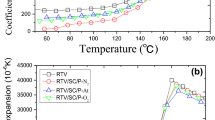Abstract
Silicone polymers exhibit good mechanical properties for a variety of biomedical and industrial applications. For instance, silicone rubber has been used for voice prostheses1,2, urinary catheters3, contact lens material4, and icing coating materials. However, their inherently high hydrophobicity limits certain applications of this material despite its favorable mechanical properties6. Plasma treatment of silicone polymers may affect their hydrophobicity and therewith their boundability to other materials without affecting the bulk properties. Plasma treatment often involves progressive oxidation of the surface and cross-linking of surface molecular groups which inhibits migration of low molecular weight oligomers to the surface. Various gases have been used to modify silicone polymers by plasma treatment, such as oxygen6–8, helium6,9, ammonia7, carbon dioxide7, nitrogen6,10 and argon6,7,10. Frequently a thin cross-linked, sometimes water washable, silica-like surface layer was produced by plasma treatment, but there is no consensus about the nature of the chemical groups produced at the outermost surface. The surface hydrophilicity created by plasma treatment is often lost over time 6–8,11,12. This so-called hydrophobic recovery can be influenced by the storage conditions, whether in air or in liquid, temperature or subsequent adsorption of a surfactant13.
Access this chapter
Tax calculation will be finalised at checkout
Purchases are for personal use only
Preview
Unable to display preview. Download preview PDF.
Similar content being viewed by others
References
J.D. Cooper, F.G. Pearson, G.A. Patterson, T.R.J. Todd, R.J. Ginsberg, M. Goldberg and P. Waters, Use of silicone stents in the management of airway problems, Ann. Thorac. Surg. 47: 371 (1989).
T.R. Neu, H.C. van der Mei, H.J. Busscher, F. Dijk and G.J. Verkerke, Biodeterioration of medical-grade silicone rubber used for voice prostheses: a SEM study, Biomaterials 14: 459 (1993).
B.F. Farber and A.G. Wolff, Salicilic acid prevents the adherence of bacteria and yeast to silastic catheters, J. Biomed. Mat. Res. 27: 599 (1993).
F.J. Holly and M.J. Owen, in: Physicochemical Aspects of Polymer Surfaces, K.L. Mittal, ed. Plenum Press, New York (1983).
L-O. Andersson, C-L. Gölander and S. Persson, Ice adhesion to rubber materials, J. Adhesion Sci. Technol. 8: 117 (1994).
M.J. Owen and P.J. Smith, Plasma treatment of polydimethylsiloxane, J. Adhesion Sci. Technol. 8: 1063 (1994).
E.P. Everaert, H.C. van der Mei, J. de Vries and H.J. Busscher, Hydrophobic recovery of repeatedly plasma-treated silicone rubber. Part 1. storage in air, J. Adhesion Sci. Technol. 9: 1263 (1995).
M. Mona, E. Occhiello, R. Marola, F. Garbassi, P. Humphrey and D. Johnson, On the aging of oxygen plasma-treated polydimethylsiloxane surfaces, J. Colloid Interface Sci. 137: 11 (1990).
P.M. Triolo and J.D. Andrade, Surface modification and evaluation of some commonly used catheter materials. I. Surface properties, J. Biomed. Mater. Res. 17: 129 (1983).
S.R. Gaboury and M.W. Urban, Spectroscopic evidence for Si-H formation during microwave plasma modification of poly(dimethylsiloxane) elastomer surfaces, Polym. Communications 32: 390 (1990).
H.C. van der Mei, I. Stokroos, J.M. Schakenraad and H.J. Busscher, Aging effects of repeatedly glow-discharged polyethylene: influence on contact angle, infrared absorption, elemental surface composition, and surface topography, J. Adhesion Sci. Technol. 5: 757 (1991).
R.C. Chatelier, X. Xie, T.R. Gengenbach, and H.J. Griesser, Effects of plasma modification conditions on surface restructuring, Langmuir 11: 2585 (1995).
M.I. van Dyke, H. Lee and J.T. Trevors, Applications of microbial surfactants, Biotech. Adv. 9: 241 (1991).
G. Beamson and D. Briggs, High Resolution XPS of Organic Polymers, The Scienta ESCA 300 Database, John Wiley & Sons, Chichester, (1992).
Author information
Authors and Affiliations
Editor information
Editors and Affiliations
Rights and permissions
Copyright information
© 1996 Springer Science+Business Media New York
About this chapter
Cite this chapter
Everaert, E.P., van der Mei, H.C., Busscher, H.J. (1996). XPS Analyses of Plasma-Treated Silicone Rubber. In: Ratner, B.D., Castner, D.G. (eds) Surface Modification of Polymeric Biomaterials. Springer, Boston, MA. https://doi.org/10.1007/978-1-4899-1953-3_11
Download citation
DOI: https://doi.org/10.1007/978-1-4899-1953-3_11
Publisher Name: Springer, Boston, MA
Print ISBN: 978-1-4899-1955-7
Online ISBN: 978-1-4899-1953-3
eBook Packages: Springer Book Archive




